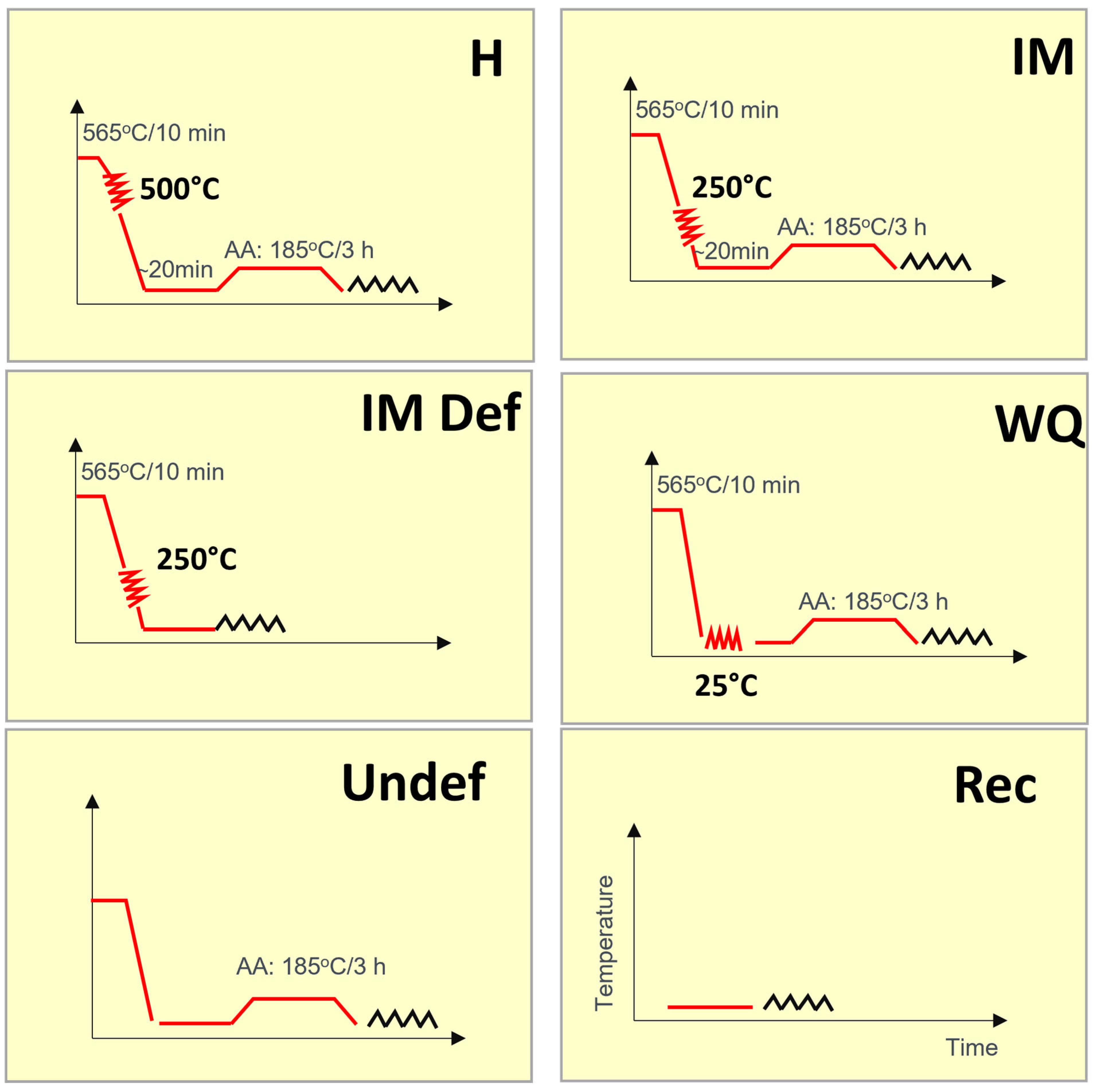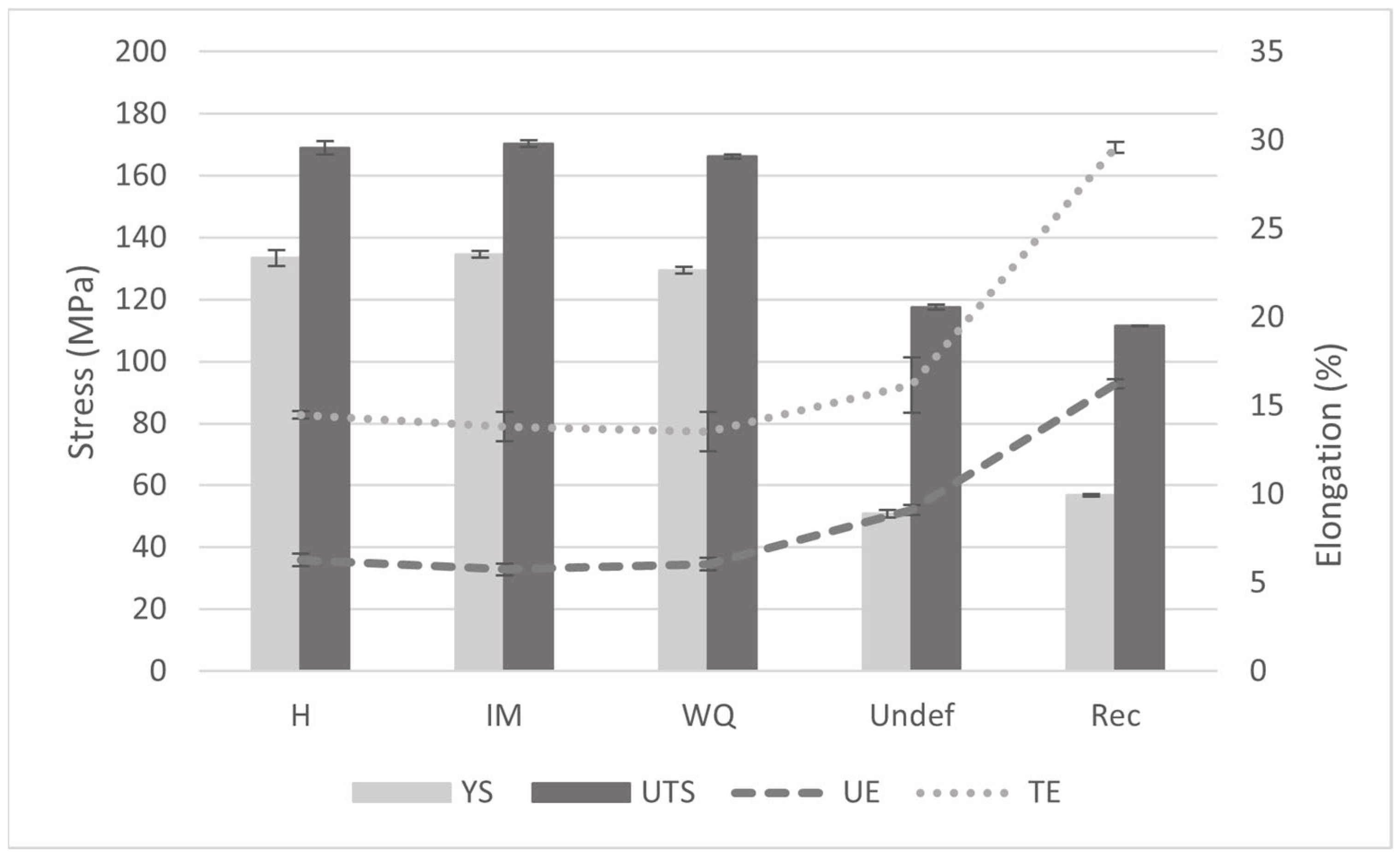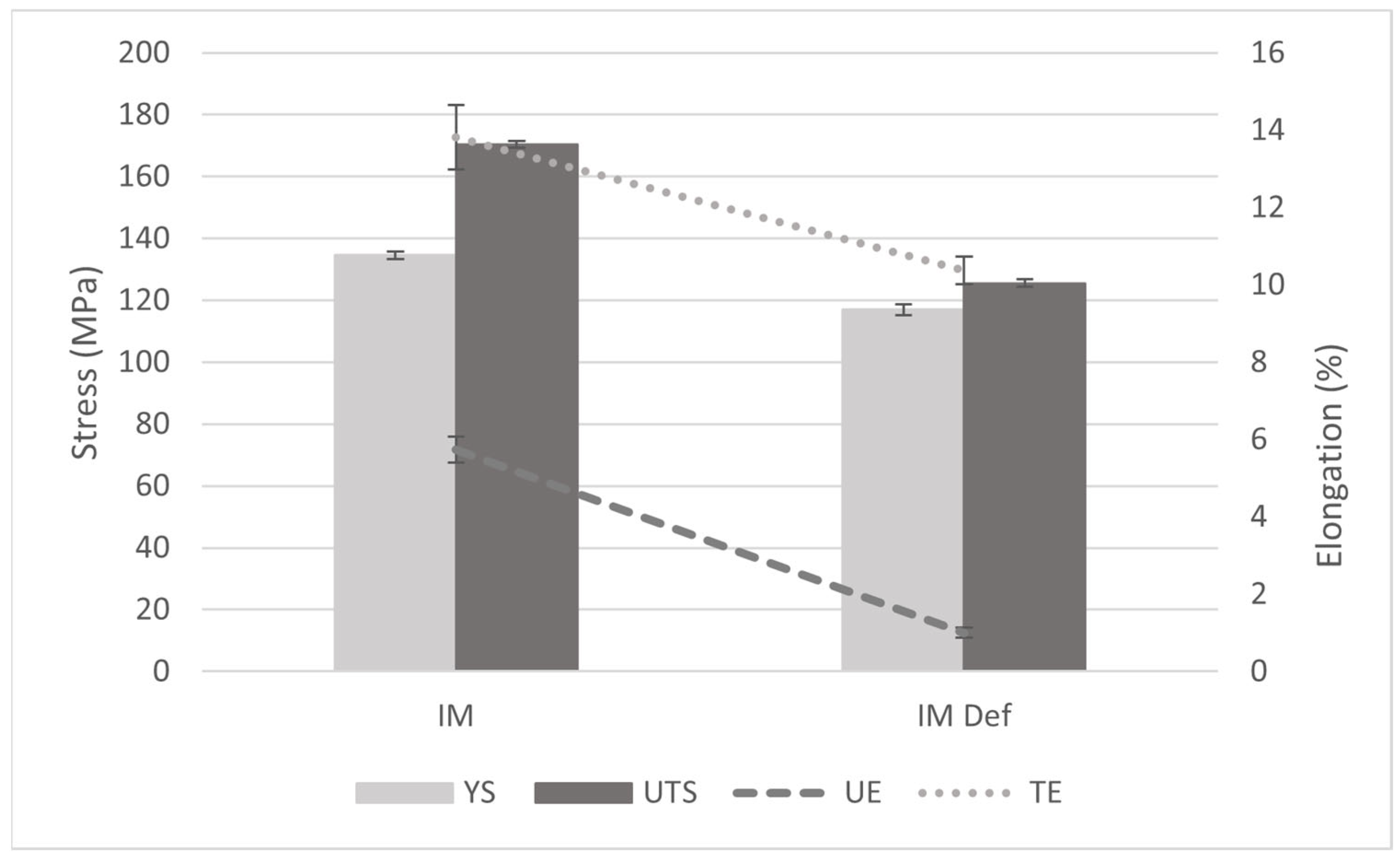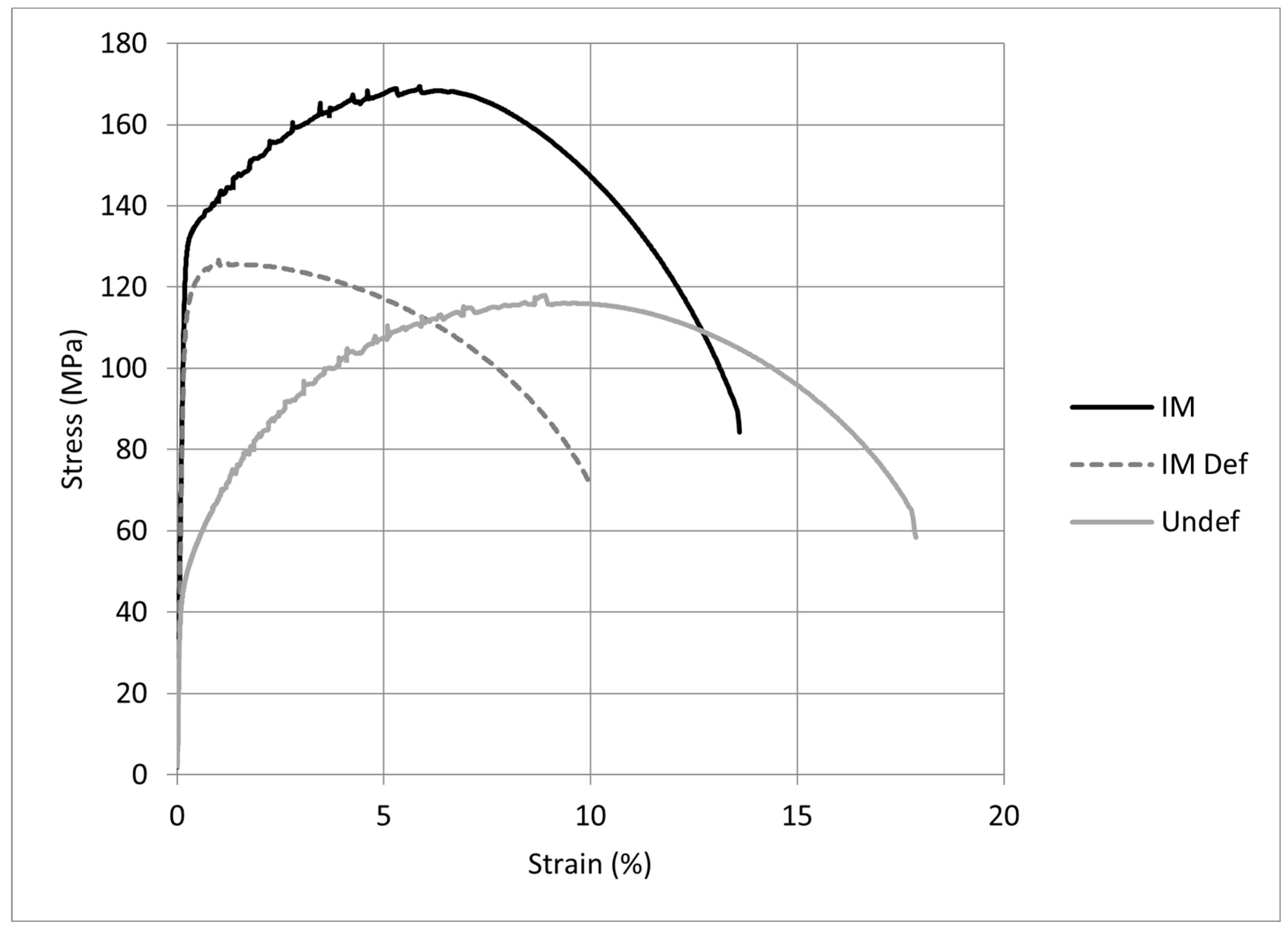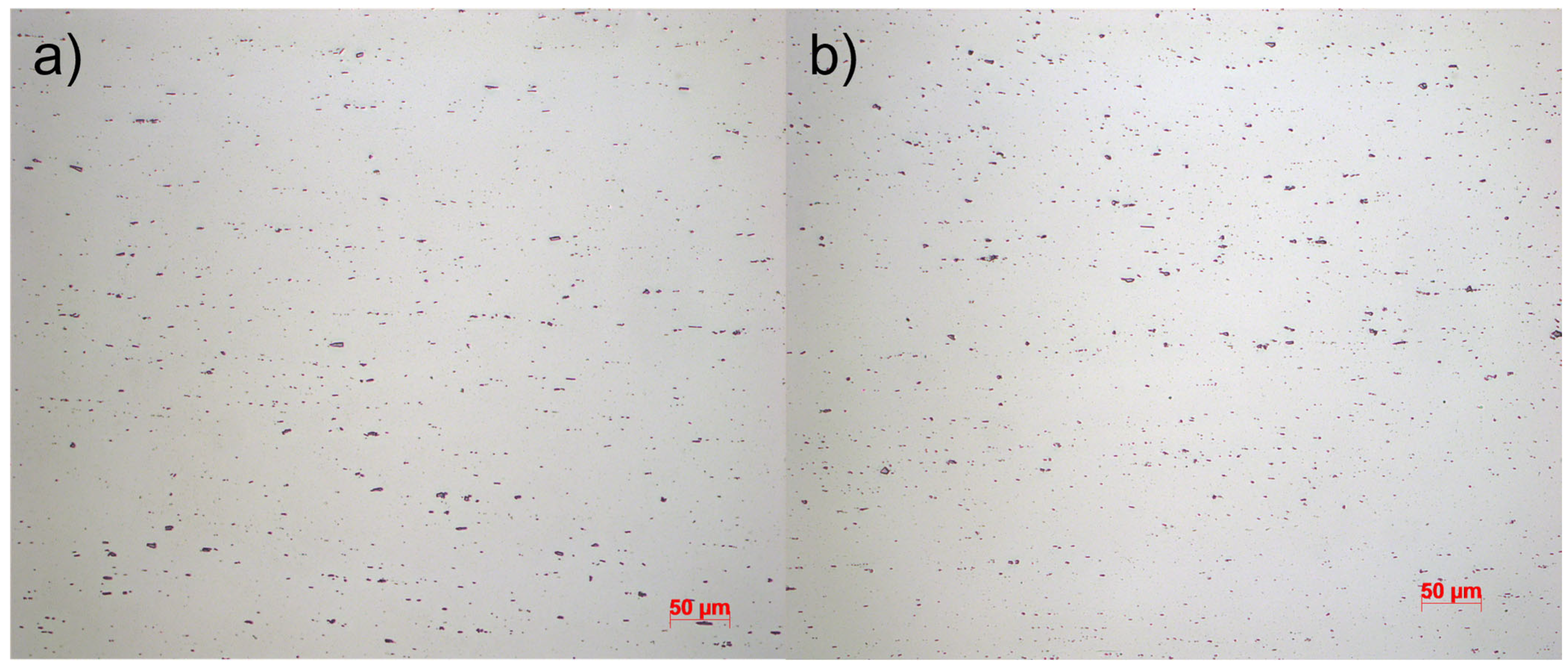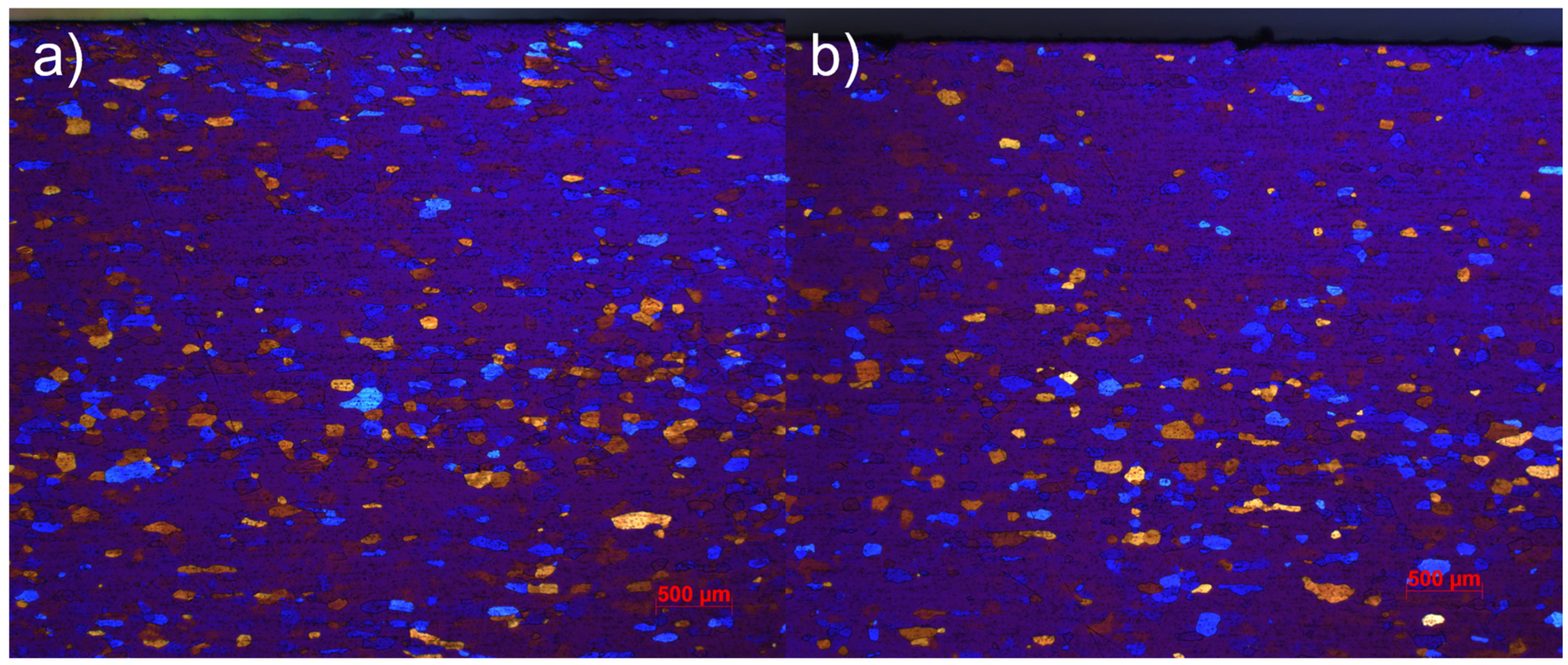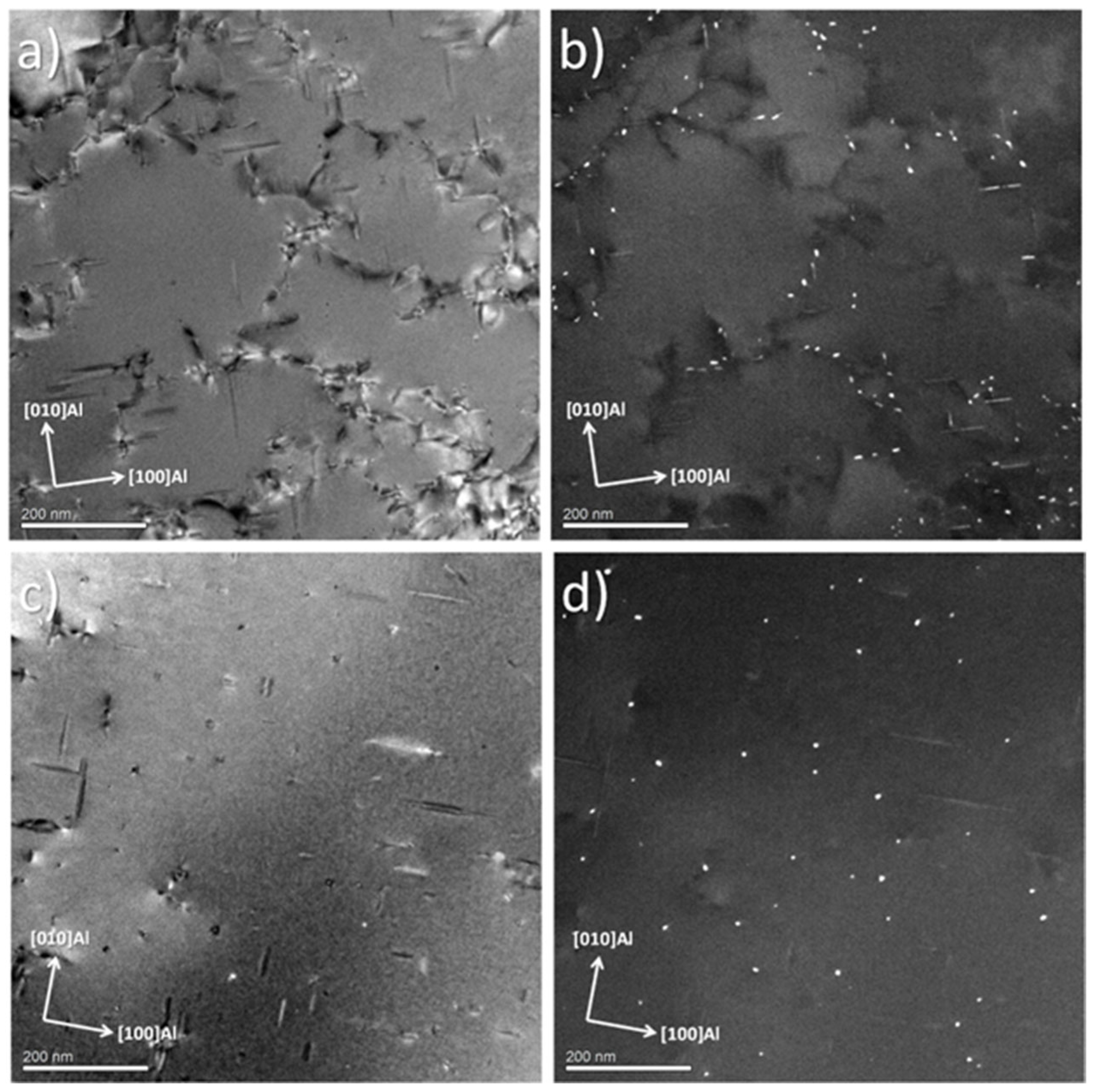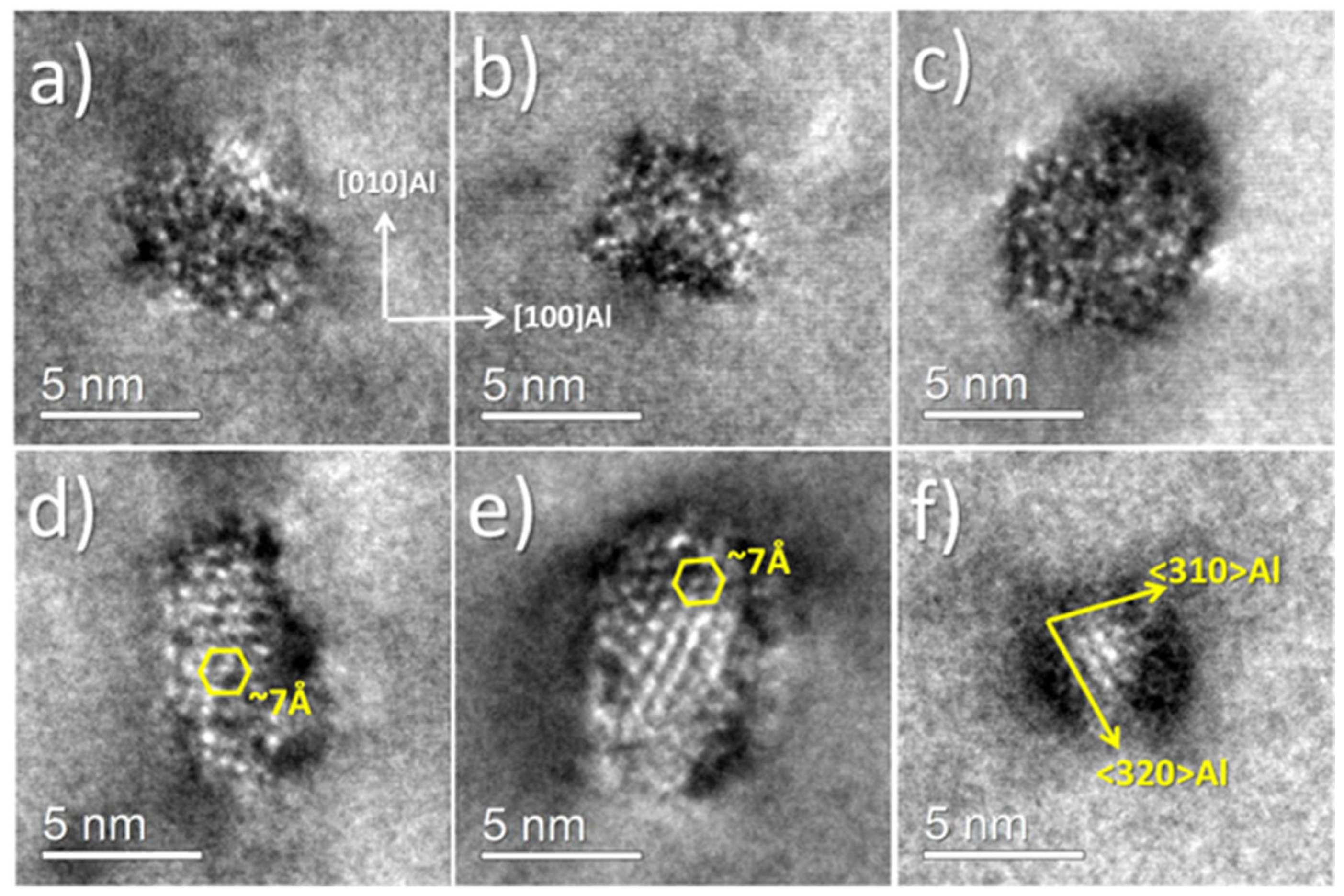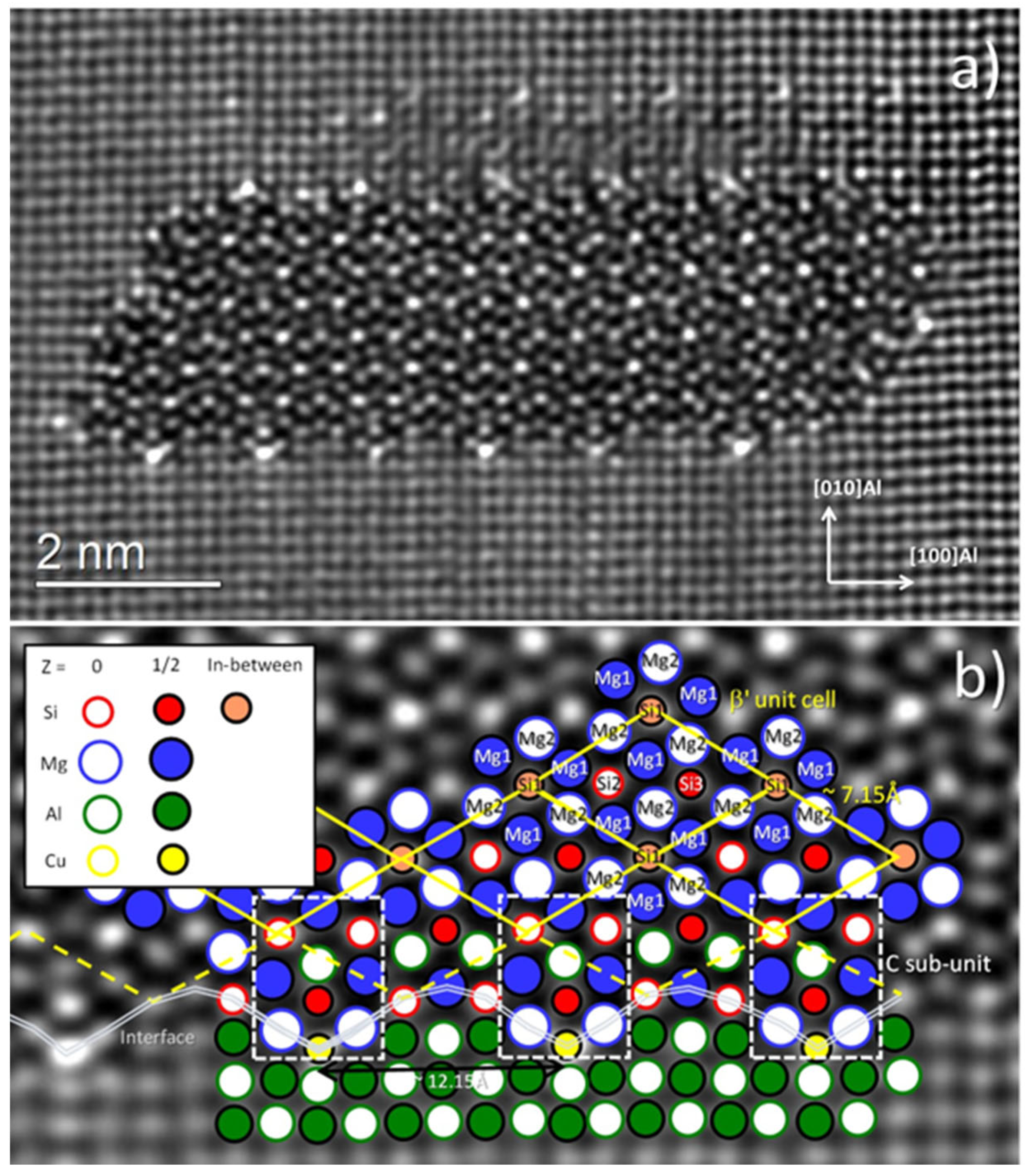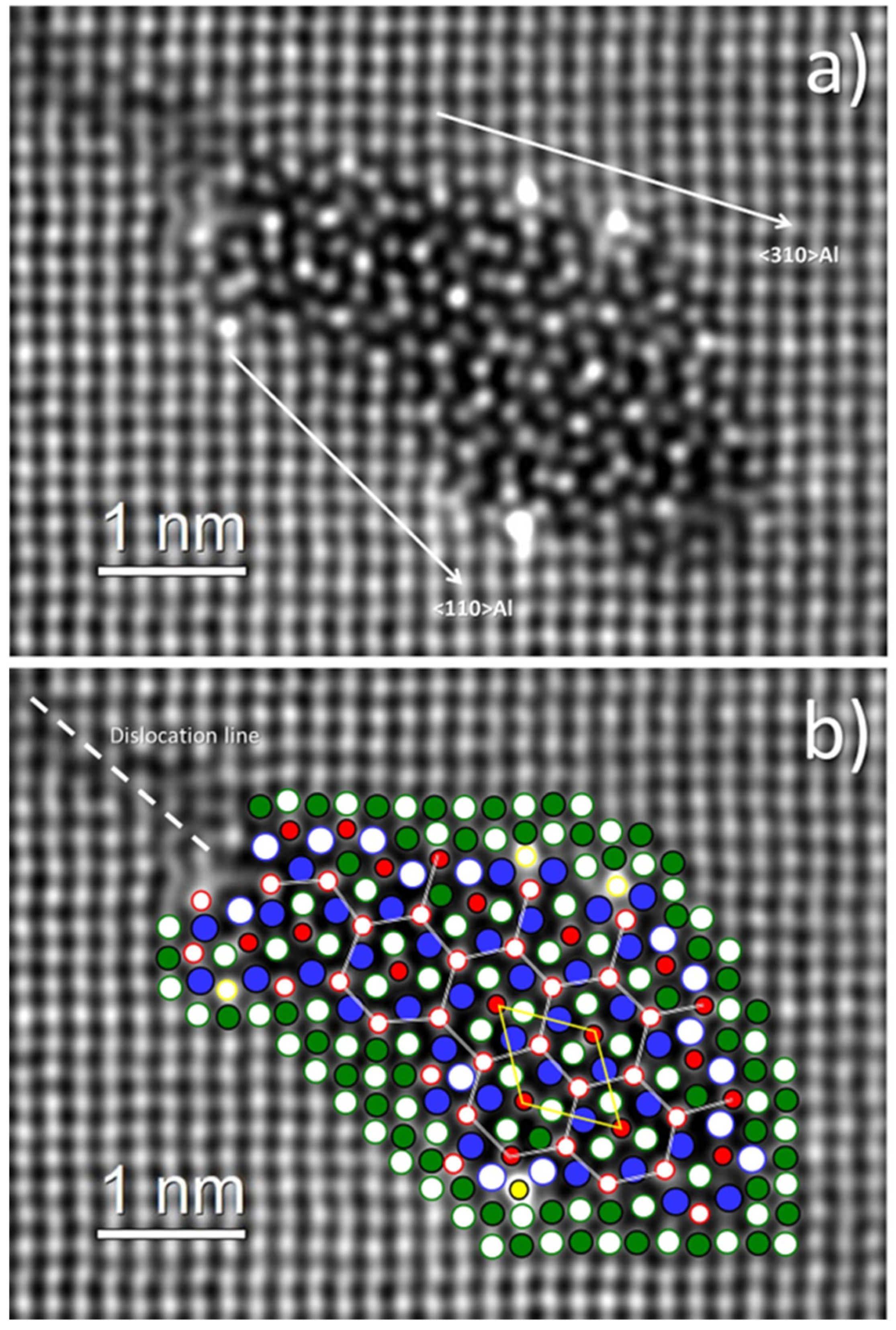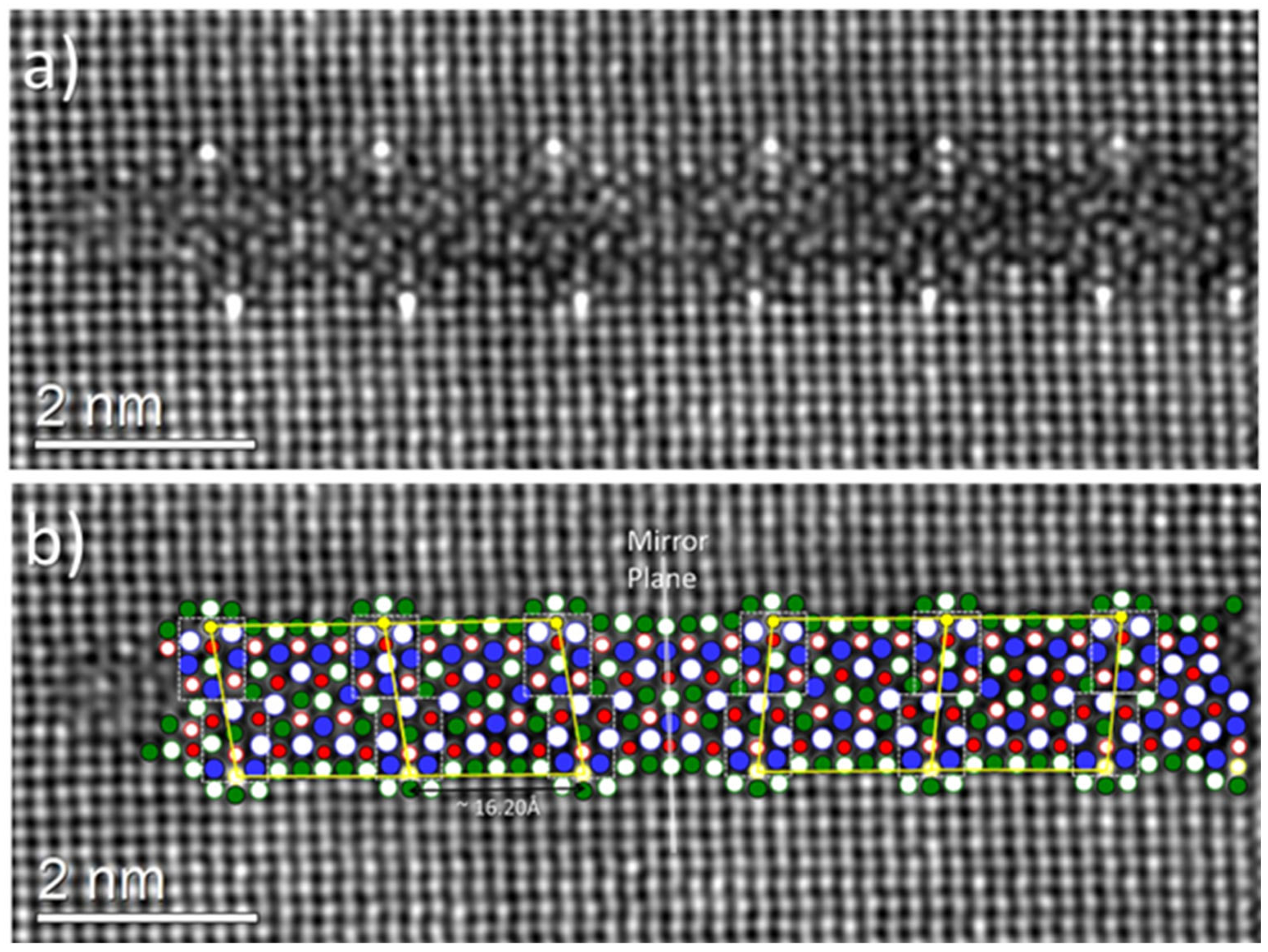1. Introduction
Both 5xxx- and 6xxx-series aluminum are extensively used in the automotive industry due to their excellent strength-to-weight ratio, good corrosion resistance, and good formability [
1]. The 5xxx series is non-heat-treatable, and strength is gained mainly from solid solution and strain hardening [
2]. However, in 6xxx-series alloys, strength is gained mainly through precipitation hardening during artificial ageing [
3].
The precipitation sequence in 6xxx-series alloys has been extensively studied and is well known. The main hardening phase is the coherent needle-shaped β’’, but during overageing, more stable semicoherent precipitates are formed [
4]. When the Mg–Si ratio is varied, several different types of ordered and disordered particles will precipitate [
5]. All the metastable precipitates have one full coherency direction with the <100>Al directions in the face-centered cubic Al matrix. For this reason, they take needle/rod/plate morphologies with elongation in one <100>Al direction. It means that the atoms in their structures arrange in cross section on two planes with a
Al/2 = 2.025 Å separation, each plane having a
Al = 4.05 Å periodicity along the needle length. Different precipitate types have different atomic arrangements on the two planes, which give variable symmetries and compositions of the metastable phases. It was recently discovered that all the metastable precipitates are connected by a set of common construction rules, which dictate that each Al atom must have 12 near neighbor atoms, each Mg 15, and each Si 9 [
6]. The consequence of these rules is that when viewed in projection along the needle length, each Al atomic column in the cross section will sit in a fourfold symmetry in respect to the nearest neighbor atomic columns, each Mg column will sit in a fivefold symmetry, and each Si in a threefold symmetry [
7]. Each Al column will be surrounded by four near columns with opposite heights (located on the other plane), each Mg by five, and each Si by three near columns of opposite heights. In Cu-containing alloys, Cu atomic columns can take both threefold and fourfold symmetries when partly replacing Al columns in the interfaces of precipitates with the matrix [
8]. The consequence of these rules is that an exact atomic overlay can be made on two-dimensional Z-contrast atomic-resolution high-angle annular dark-field scanning transmission electron microscopy (HAADF-STEM) images of precipitate cross sections, enabling their full characterization. Another consequence of the rules is that the projected positions of the Si atomic columns in the precipitate cross-section plane are nearly hexagonal with a projected separation of approximately 4 Å. This has been named ‘the Si-network’ and provides a structural connection between the different precipitate structures [
9].
Recent works have shown that precipitation hardening can occur in 5xxx-series aluminum alloys if Zn [
10,
11] is added. Increased mechanical properties were observed after cold rolling and ageing in a 5083 alloy with 2 wt% Zn, with an effect of both the work and precipitation hardening [
10]. A nonisothermal heat treatment of the 5083 alloy showed increased mechanical properties, enhanced ageing kinetics, and improved corrosion resistance [
11]. However, the increased mechanical properties depended on the choice of heat treatment.
An Al–3Mg alloy with Cu showed the presence of GPB (Guinier–Preston–Bagaryatsky) zones after paint baking similar to what has been found in 2xxx-series aluminum alloys [
12]. However, a significant hardening occurred even though the Cu additions in this alloy (<0.1 at%) was much lower than what is commonly found in Al–Cu–Mg alloys (>1 at%) [
13].
β-Mg
3Al
2 can precipitate during sensitization of the alloys, but this can cause increased susceptibility to corrosion [
14] and does not have much impact on mechanical properties [
15]. It has been shown that the heat treatment of 5083-H116 [
2], an alloy containing more solute Mg than the alloy investigated in this paper, can lead to a reduction in mechanical properties due to the precipitation of β-Mg
3Al
2 on grain boundaries, and lead to less solid solution hardening of the material.
Prestraining (cold rolling reduction) increased the number of nucleation sites and influenced the precipitation kinetics of β-Mg
3Al
2 precipitates. [
16]. Heterogeneous precipitation with a shorter distance between precipitates than in the nonstrained material was observed.
The precipitation of β-Mg
3Al
2 has been modelled and experimentally investigated in tempers with a different strain hardening, i.e., different cold rolling reduction [
17]. The nucleation and coarsening rates of the precipitates were different in the investigated tempers.
Increased mechanical properties were found during high-pressure heat treatment in a 5005 alloy [
18]. This increase was attributed to a refinement of grains during the process.
The dislocation density of an alloy after forming can be measured in various ways [
19], both directly and indirectly. The direct ways are complicated and require advanced scientific equipment, but the effect of the dislocations on macroscopic properties can be measured more easily. It is well known that dislocations prevent the motion of other dislocations, hence increasing the yield and tensile strength of the material [
20]. The increase or reduction in dislocations can therefore be measured by the mechanical properties if no other hardening effect is present.
The deformation temperature has an impact on dynamic recovery during deformation [
21]. Deformation at cryogenic temperatures was performed, and the yield, tensile, and elongation were improved compared with room temperature deformation. This increase in mechanical properties was attributed to a reduction in dynamic recovery after deformation at cryogenic temperatures and a higher dislocation density in the material.
In a 6xxx-series alloy, precipitation occurs, and the dislocation density cannot be inferred by measuring the mechanical properties. This work-hardening effect has been investigated and modelled [
22,
23]. The effect of deformation at both room temperature and elevated temperatures in a 6xxx aluminum alloy has been investigated, and deformation at elevated temperatures leads to a reduction in mechanical properties [
22]. The authors attributed this decrease to a lower efficiency to store dislocations, as well as to dynamic recovery. Khadyko et al. [
23] proposed a crystal plasticity and precipitation model for the precipitation and work hardening of 6XXX alloy, which showed good predictions of relative changes in work hardening, but was inaccurate for early states of ageing as it did not account for the incubation time.
In recent years, hot die quenching during deformation has been developed to produce components with high ductility and with the potential of excellent mechanical properties after artificial ageing [
24]. The hot stamping-in-die quenching process has been found to increase the yield strength of a 5083 alloy, while the elongation was slightly reduced [
25]. Finite element simulation showed that the hot stamping process was more suitable for the formation of skin when compared with hot drawing.
The hot form quenching of a 7055 aluminum alloy combined with preageing and simulated baking (ageing) was found to increase the mechanical properties by 10% compared with similar alloys as the precipitate sequence could be manipulated to increase the number density of strengthening η’-precipitates [
26]. In a 7075 aluminum alloy, the increased dislocation density after hot form quenching leads to an increased precipitation density and an increased strengthening contribution from dislocations and precipitation despite a slight reduction in solid solution strengthening [
27].
Based on these considerations, an idea to experimentally measure the dislocation density was to use a non-heat-treatable 5005 alloy to measure the effect of the isothermal heat treatment on the mechanical properties and, hence, infer if there is a reduction in dislocation density due to dynamic recovery. In an alloy where no precipitation occurs, the changes in mechanical properties during isothermal heat treatment will be closely linked to the dislocation density of the material.
As an unexpected increase in mechanical properties was found in the 5005 alloy after isothermal heat treatment, the focus became to understand the reason for this increase and to investigate whether precipitates, and what type, were formed during the isothermal heat treatment.
2. Materials and Methods
A 5005 rolled aluminum sheet with the alloy composition given in
Table 1 was used for the experiments. The main alloying element was Mg, but small amounts Si, Fe, Cu, Mn, and Ti were also present in the alloy.
The alloy sheet with a thickness of 5.4 mm was cut into blanks with an area of 150 × 25 mm, with the longitudinal direction parallel to the rolling direction. The blanks were heated to 565 °C in an air circulation furnace and kept at this temperature for 10 min. The blanks were then cooled by different methods to a predefined target temperature before insertion into a flat deformation tool attached to a 300-ton hydraulic press. The blanks were compressed from 5.4 mm to approximately 4.7 mm, giving a thickness reduction of 13%. The deformation tool was kept at room temperature during the entire experiment, and the blank was quenched in the tool to room temperature, a.k.a. hot form quenching [
24].
Cooling to the deformation temperature was performed both with water quenching for rapid cooling to room temperature and with a cooling tool made of steel plates that allowed rapid and controlled cooling to a desired temperature. The deformation temperatures investigated are given in
Table 2, where 500 °C was the highest temperature that could be reached due to air cooling during the transportation of the blank from the furnace to the press. The cooling rates and times for the different cooling media to the selected temperatures were measured repeatedly with a thermocouple on blanks before the experiment, and a stopwatch was used to determine the end of cooling based on this during the experiment. To reach the intermediate deformation temperature of 250 °C, the time in the cooling tool was 8 s. The cooling tool was kept at a temperature of 100 °C to sufficiently reduce the cooling rate to be able to control the end cooling temperature.
An undeformed blank went through the solution heat treatment, but was water-quenched before artificial ageing to be able to observe the effect of no deformation on the final mechanical properties.
The blanks were then isothermally heat-treated at 185 °C for 3 h to obtain the final temper before they were machined to tensile test specimens and tested according to ISO 6892-1:2019 [
28] in a Zwick Z250 tensile testing machine (ZwickRoell GmbH, Ulm, Germany). Three parallels in each condition were tested to obtain the mechanical properties. Both the deformed and undeformed tensile test samples were oriented along the rolling direction of the original sheet material.
One set of blanks, intermediate deformed (IM Def), was not isothermally heat-treated, so the effect of the heat treatment on the mechanical properties can also be investigated. The thermomechanical treatment and the labelling of all conditions produced for this work are listed in
Table 2 and shown schematically in
Figure 1.
The intermediate (IM) and undeformed (Undef) conditions were, based on the mechanical properties, selected to be more thoroughly investigated.
The samples were cast in epoxy, ground, and polished before investigating in an optical microscope. The grain structure was obtained by using polarized light after the sample had been anodized in Barker’s reagent (HBF4) at 40 V for 60 s with Struers LectroPol-5 (Struers ApS, Ballerup, Denmark).
A JEOL JEM 2100 TEM (transmission electron microscope) (JEOL, Tokyo, Japan) was used to determine the precipitate microstructure present after the artificial aging in the IM and Undef conditions. The microscope has a LaB
6 gun and was operated at 200 kV. It is equipped with a Gatan imaging filter (GIF) that enables the measurement of specimen thickness corresponding to recorded bright-field (BF) and dark-field (DF) images by electron energy loss spectroscopy (EELS) (Gatan, Inc., Pleasanton, CA, USA). The precipitates found were of the type typical for Al–Mg–Si(–Cu) alloys with needle morphology along the crystallographic <100>Al directions. Therefore, a methodology described in [
5] was used to determine their parameters, such as volume density, average needle length, cross section, and volume fraction. A total of 12 bright-field images and their corresponding dark-field images were recorded with the matrix oriented along <001>Al from each condition, and the specimen thickness in each image was measured by EELS to determine the precipitate volume density. The measured thicknesses were between 70 and 130 nm with an average of approximately 110 nm in each condition. The lengths of 380 needles in the Undef condition and 610 needles in the IM condition were measured to determine the average needle length. In addition to the abovementioned images, 20 bright-field images at higher magnifications from the Undef condition and 37 from the IM condition were recorded to measure the precipitate’s cross-section areas. A total of 44 cross sections were measured from the Undef condition, and 229 from the IM condition.
The precipitate types were determined by Z-contrast, atomic-resolution HAADF-STEM (high-angle annular dark-field scanning transmission electron microscopy) imaging using a probe Cs-corrected JEOL JEM-ARM200F operated at 200 kV. The probe size was 0.1 nm, the convergence semi-angle was 27.42 mrad and the inner and outer collection angles were 51 and 203 mrad, respectively. All HAADF-STEM images shown in this work were taken with the grains oriented along a <001>Al direction.
TEM samples were prepared from cross sections along the rolling direction, i.e., the long direction of the deformed blanks. They were ground to thin foils of about 100 mm thickness with successively finer grinding paper up to #4000 grit. Samples with Ø3 mm were stamped out and electropolished in a Struers TenuPol-5 unit with the electrolyte (1/3 nitric acid + 2/3 methanol) kept at −20 °C.
4. Discussion
The mechanical properties of the 5005 alloy are significantly changed after a combined deformation and ageing process compared with the conditions without deformation or ageing. This demonstrates that it is possible to significantly increase the strength of an alloy that has previously been considered non-heat-treatable. The standard states that the 5005 alloy can achieve higher strength in some conditions, but the minimum elongation is then significantly lower (less than 4%) than what has been found here [
32]. After deformation, the dislocation density is increased, and this both increases the diffusion speed of the alloying elements and acts as nucleation sites for precipitation. In the present work, it is the presence of Si that facilitates the formation of precipitates despite its low concentration of only 0.15 wt%.
The deformation in itself can be seen to greatly increase the yield strength while slightly increasing the ultimate tensile strength, as shown in
Table 2 and
Table 3, but the combination of artificial ageing and deformation shows an even greater increase, as shown in
Figure 3. This means that there is a significant strength contribution from both the introduction of dislocations and the increased precipitation density found after artificial ageing.
The initial deformation temperature does not have any impact on the mechanical properties. In this case, the tool was kept at room temperature, which led to the quenching of the material during deformation and, hence, a reduction in dynamic recovery. It is likely that most of the deformed conditions were cooled to a temperature close to room temperature when the deformation ended, and this locked in the dislocations and kept the deformation structure and strength contribution of all these conditions at a similar level. To improve this study, heated tools that could keep the material at the selected temperature during deformation are necessary to clearly determine if the deformation temperature influences the final mechanical properties.
The grain structure and the primary particle distribution are not changed after the deformation, with small to no visible differences between the investigated conditions. The amount of deformation is too low to observe any changes in the optical micrographs that might show up if higher deformations levels were investigated.
The precipitates that are found in the alloy are well known from the 6xxx-series system, but in the IM condition, they are mainly distributed along dislocation lines, indicating a segregation of solute elements to the dislocations that contribute to the increased precipitate density compared with the nondeformed sample. The segregation of the solute elements to the dislocation lines enables them to act as nucleation sites for precipitates with well-defined cross sections and for precipitates that are decorating the dislocation lines. It should be mentioned that all these precipitates are viewed in cross section and extend along the viewing <001>Al directions. The higher precipitate density in the IM condition is increasing its mechanical properties as compared with the undeformed condition. The precipitates in both conditions are typical for the Al–Mg–Si(–Cu) system, built according to the construction rules given in [
6] and containing the well-known Si-network [
9]. Many precipitates nucleated on dislocations in the IM condition had interfaces along <100>Al directions that were found to be stabilized by Cu-rich atomic columns forming local C subunits. These interfaces could accommodate various bulk crystal structures, as the precipitates in
Figure 9,
Figure 11 and
Figure 12 show. This is an indication that Cu is important in enhancing the precipitation hardening in predeformed conditions, even when present at low concentrations. It can be observed that the number of Cu-containing columns is very low in the overlaid precipitates in respect to the total number of atomic columns in these precipitates. Most likely, the C subunits stabilize the precipitate interfaces due to the strong covalent bonding between the Cu atomic columns and the nearby Si columns that are part of the Si-network. The C subunits along <100>Al directions tend to form with certain periodicities, such as 3d
Al (12.15 Å) and 4d
Al (16.20 Å), also reported in [
30], most likely related to strain alleviation when the bulk structure becomes periodic along <100>Al. It is interesting to note that no precipitates with elongated cross sections or with cross sections along <100>Al were observed in the Undef condition, which indicates that the formation of C subunits and the precipitate’s interfaces along <100>Al are enhanced by the predeformation.
It is obvious that the low amount of Si present in the alloy is responsible for precipitation in quantities able to increase the mechanical properties. It was expected that such amount was not sufficient to create precipitates and that the alloy would therefore give knowledge about the effect of an isothermal heat treatment on the strength contribution from dislocations, hence indirectly giving information about the dislocation density. Instead, we obtained a significant increase in mechanical properties, and found that the combination of mechanical deformation and isothermal artificial ageing increased the yield strength by more than 120% and the ultimate tensile strength by 50%. We were not able to determine the effect of dislocation density on mechanical properties after deformation, but it can be clearly seen in
Figure 7 that there is a significant increase in dislocation density after deformation when compared with the undeformed material. The low Si content in this 5005 alloy allowed for precipitation to occur during deformation, but according to the standard, a content up to 0.3 wt% is allowed for 5005 alloys [
33]. In a recycling context, where you are likely to have issues keeping the Si level low, the increased level might be beneficial and cause a strength/ductility increase compared with alloys with lower Si content, thus enabling the use of more postconsumer scrap in the recycled material. In addition, a higher Si content should lower the deformation requirement to obtain precipitation hardening, thus making higher mechanical properties possible.
Due to precipitation strengthening, the main idea of investigating the effect of the isothermal heat treatment on the dislocation annihilation was not feasible and would require a purer alloy without Si where strengthening precipitation is impossible. If any dislocation annihilation has occurred during the artificial ageing, the contribution to mechanical properties is significantly lower than the precipitation strengthening observed in this alloy.
Based on earlier works, it is important to control the amounts of other solute elements (Zn and especially Cu) and make sure that the precipitation of other known phases will not occur [
10,
11,
12]. This could indicate a future research topic to be studied to determine the effect of the recovery of dislocations during artificial ageing temperatures without any influence of precipitates on the mechanical properties.
